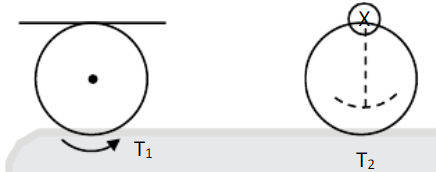A ring is hung on a nail. It can oscillate without slipping or sliding (i) in its plane with a time period T1 and (ii) , back and forth in a direction perpendicular to its plane , with a period T2. The ratio T1T2 will be :
2√3
23
3√3
√23
To solve the problem, we need to find the ratio of the time periods T1 and T2 for a ring oscillating in two different modes.
1. Understanding the Problem:
- The ring can oscillate in its plane (time period T1) and back and forth in a direction perpendicular to its plane (time period T2).
- We need to find the ratio T1T2.
2. Time Period of Oscillation in Plane (T1):
- For a ring oscillating in its plane, we can derive the equation of motion using the moment of inertia about the point of suspension.
- The moment of inertia I1 about the nail is given by:
I1=2MR2
where M is the mass of the ring and R is its radius.
- The angular frequency ω1 for small oscillations can be expressed as:
ω1=√gL
- Therefore, the time period T1 is:
T1=2π√I1k=2π√2MR2Mg=2π√2R2g
3. Time Period of Oscillation Perpendicular to the Plane (T2):
- For oscillation in a direction perpendicular to its plane, the moment of inertia I2 is given by:
I2=12MR2+MR2=32MR2
- The angular frequency ω2 for this motion can be expressed as:
ω2=√gL
- Therefore, the time period T2 is:
T2=2π√I2k=2π
⎷32MR2Mg=2π√3R22g
4. Finding the Ratio T1T2:
- Now we can find the ratio of the two time periods:
T1T2=2π√2R2g2π√3R22g
- Simplifying this gives:
T1T2=√2√32=√2√3/√2=2√3
5. Final Answer:
- Thus, the ratio T1T2 is:
T1T2=2√3
- The ring can oscillate in its plane (time period T1) and back and forth in a direction perpendicular to its plane (time period T2).
- We need to find the ratio T1T2.
- For a ring oscillating in its plane, we can derive the equation of motion using the moment of inertia about the point of suspension.
- The moment of inertia I1 about the nail is given by:
I1=2MR2
where M is the mass of the ring and R is its radius.
- The angular frequency ω1 for small oscillations can be expressed as:
ω1=√gL
- Therefore, the time period T1 is:
T1=2π√I1k=2π√2MR2Mg=2π√2R2g
- For oscillation in a direction perpendicular to its plane, the moment of inertia I2 is given by:
I2=12MR2+MR2=32MR2
- The angular frequency ω2 for this motion can be expressed as:
ω2=√gL
- Therefore, the time period T2 is:
T2=2π√I2k=2π
⎷32MR2Mg=2π√3R22g
- Now we can find the ratio of the two time periods:
T1T2=2π√2R2g2π√3R22g
- Simplifying this gives:
T1T2=√2√32=√2√3/√2=2√3
- Thus, the ratio T1T2 is:
T1T2=2√3
Topper's Solved these Questions
Similar Questions
If a charged particle is a plane perpendicular to a uniform magnetic field with a time period T Then
View SolutionStatement I: A circular metal hop is suspended on the edge by a hook. the hoop can oscillate side to side in the plane of the hoop, or it can oscillate back and forth in a direction perpendicular to the plane of the hoop. The time period of oscillation would be more when oscillation are carried out in the plane of hoop.
Statement II: Time period of physical pendulum is more if moment of inertial of the rigid body about corresponding axis passing through the pivoted point is more.
View SolutionA ring-1 oscillate with period T1 about tangential axis in the plane of ring and an another ring-2 oscillate with period T2 about tangential axis tangential axis perpendicular to plane of ring T1T2?

View SolutionTime period for a magnet is T. If it is divided in four equal parts along its axis and perpendicular to its axis as shown then time period for each part will be

View SolutionA body is in SHM with period T when oscillated from a freely suspended spring. If this spring is cut in two parts of length ratio 1:3& again oscillated from the two the two parts separatedly, then the periods are T1&T2 then find T1/T2.
View SolutionWhat is the ratio of time periods (T1/T2) in second orbit of hydrogen atom to third orbit of He+ ion?
View SolutionThe time t1 and t2 are time period for 13rd and 23rd completion of two first order reactions If the half lives are in the ratio 10:3. then the ratio of t1 and t2 will be
View SolutionA thin magnetic needle oscillates in a horizontal plane with a period T. It is broken into n equals parts. The time period of each part will be
View SolutionA bar magnet is oscillating in the earth's magnetic field with a time period T. If the mass is increased four times, then its time period will be:
View SolutionA simple pendulum has a time period T1 when on the earth's surface and T2 when taken to a height R above the earth's surface, where R is the radius of the earth. The value of T2T1 is
View Solution
